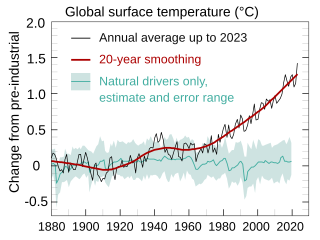
Attribution of recent climate change is the effort to scientifically ascertain mechanisms responsible for recent global warming and related climate changes on Earth. The effort has focused on changes observed during the period of instrumental temperature record, particularly in the last 50 years. This is the period when human activity has grown fastest and observations of the atmosphere above the surface have become available. According to the Intergovernmental Panel on Climate Change (IPCC), it is "extremely likely" that human influence was the dominant cause of global warming between 1951 and 2010. Likely human contribution is 93%–123% of the observed 1951–2010 temperature change.

Numerical climate models use quantitative methods to simulate the interactions of the important drivers of climate, including atmosphere, oceans, land surface and ice. They are used for a variety of purposes from study of the dynamics of the climate system to projections of future climate. Climate models may also be qualitative models and also narratives, largely descriptive, of possible futures.
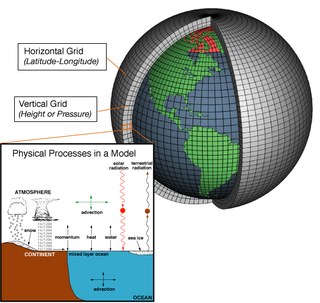
A general circulation model (GCM) is a type of climate model. It employs a mathematical model of the general circulation of a planetary atmosphere or ocean. It uses the Navier–Stokes equations on a rotating sphere with thermodynamic terms for various energy sources. These equations are the basis for computer programs used to simulate the Earth's atmosphere or oceans. Atmospheric and oceanic GCMs are key components along with sea ice and land-surface components.

Radiative forcing is the change in energy flux in the atmosphere caused by natural and/or anthropogenic factors of climate change as measured by watts / metre2. It is the scientific basis for the greenhouse effect on planets, and plays an important role in computational models of Earth's energy balance and climate. Changes to Earth's radiative equilibrium that cause temperatures to rise or fall over decadal periods are called climate forcings.

Kevin Edward Trenberth is part of the Climate Analysis Section at the US NCAR National Center for Atmospheric Research. He was a lead author of the 2001 and 2007 IPCC Scientific Assessment of Climate Change and serves on the Scientific Steering Group for the Climate Variability and Predictability (CLIVAR) program. He chaired the WCRP Observation and Assimilation Panel from 2004 to 2010 and chaired the Global Energy and Water Exchanges (GEWEX) scientific steering group from 2010 to 2013. In addition, he served on the Joint Scientific Committee of the World Climate Research Programme, and has made significant contributions to research into El Niño-Southern Oscillation.

Climate sensitivity is a measure of how much the Earth's climate will cool or warm after a change in the climate system, for instance, how much it will warm for doubling in carbon dioxide concentrations. In technical terms, climate sensitivity is the average change in the Earth's surface temperature in response to changes in radiative forcing, the difference between incoming and outgoing energy on Earth. Climate sensitivity is a key measure in climate science, and a focus area for climate scientists, who want to understand the ultimate consequences of anthroprogenic climate change.
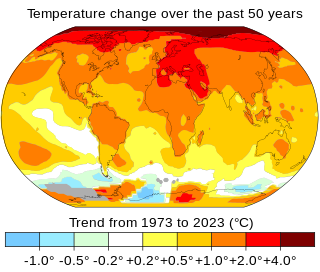
Climate change includes both global warming driven by human-induced emissions of greenhouse gases and the resulting large-scale shifts in weather patterns. Though there have been previous periods of climatic change, since the mid-20th century humans have had an unprecedented impact on Earth's climate system and caused change on a global scale.
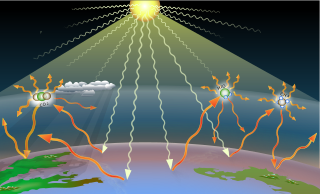
A greenhouse gas (GHG or GhG) is a gas that absorbs and emits radiant energy within the thermal infrared range, causing the greenhouse effect. The primary greenhouse gases in Earth's atmosphere are water vapor (H
2O), carbon dioxide (CO
2), methane (CH
4), nitrous oxide (N
2O), and ozone (O3). Without greenhouse gases, the average temperature of Earth's surface would be about −18 °C (0 °F), rather than the present average of 15 °C (59 °F). The atmospheres of Venus, Mars and Titan also contain greenhouse gases.
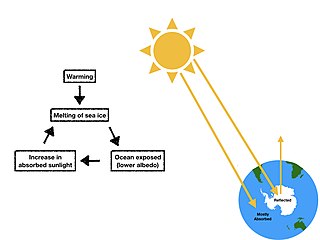
Ice–albedo feedback is a positive feedback climate process where a change in the area of ice caps, glaciers, and sea ice alters the albedo and surface temperature of a planet. Ice is very reflective, therefore some of the solar energy is reflected back to space. Ice–albedo feedback plays an important role in global climate change. For instance, at higher latitudes, warmer temperatures melt the ice sheets. However, if warm temperatures decrease the ice cover and the area is replaced by water or land, the albedo would decrease. This increases the amount of solar energy absorbed, leading to more warming. The effect has mostly been discussed in terms of the recent trend of declining Arctic sea ice. The change in albedo acts to reinforce the initial alteration in ice area leading to more warming. Warming tends to decrease ice cover and hence decrease the albedo, increasing the amount of solar energy absorbed and leading to more warming. In the geologically recent past, the ice–albedo positive feedback has played a major role in the advances and retreats of the Pleistocene ice sheets. Inversely, cooler temperatures increase ice, which increases albedo, leading to more cooling.

Climate change feedbacks are important in the understanding of global warming because feedback processes amplify or diminish the effect of each climate forcing, and so play an important part in determining the climate sensitivity and future climate state. Feedback in general is the process in which changing one quantity changes a second quantity, and the change in the second quantity in turn changes the first. Positive feedback amplifies the change in the first quantity while negative feedback reduces it.

Climate change causes a variety of physical impacts on the climate system. The physical impacts of climate change foremost include globally rising temperatures of the lower atmosphere, the land, and oceans. Temperature rise is not uniform, with land masses and the Arctic region warming faster than the global average. Effects on weather encompass increased heavy precipitation, reduced amounts of cold days, increase in heat waves and various effects on tropical cyclones. The enhanced greenhouse effect causes the higher part of the atmosphere, the stratosphere, to cool. Geochemical cycles are also impacted, with absorption of CO
2 causing ocean acidification, and rising ocean water decreasing the ocean's ability to absorb further carbon dioxide. Annual snow cover has decreased, sea ice is declining and widespread melting of glaciers is underway. Thermal expansion and glacial retreat cause sea levels to increase. Retreat of ice mass may impact various geological processes as well, such as volcanism and earthquakes. Increased temperatures and other human interference with the climate system can lead to tipping points to be crossed such as the collapse of the thermohaline circulation or the Amazon rainforest. Some of these physical impacts also affect social and economic systems.

André Léon Georges Chevalier Berger is a Belgian professor and climatologist. He is best known for his significant contribution to the renaissance and further development of the astronomical theory of paleoclimates and as a cited pioneer of the interdisciplinary study of climate dynamics and history.

A Representative Concentration Pathway (RCP) is a greenhouse gas concentration trajectory adopted by the IPCC. Four pathways were used for climate modeling and research for the IPCC fifth Assessment Report (AR5) in 2014. The pathways describe different climate futures, all of which are considered possible depending on the volume of greenhouse gases (GHG) emitted in the years to come. The RCPs – originally RCP2.6, RCP4.5, RCP6, and RCP8.5 – are labelled after a possible range of radiative forcing values in the year 2100. Since AR5 the original pathways are being considered together with Shared Socioeconomic Pathways: as are new RCPs such as RCP1.9, RCP3.4 and RCP7.
The contributions of women in climate change have received increasing attention in the early 21st century. Feedback from women and the issues faced by women have been described as "imperative" by the United Nations and "critical" by the Population Reference Bureau. A report by the World Health Organization concluded that incorporating gender-based analysis would "provide more effective climate change mitigation and adaptation."
Eric Guilyardi is a climate scientist at the Institut Pierre Simon Laplace / CNRS in France and professor of climate science at the University of Reading, in the UK. He is deputy director of the LOCEAN laboratory within IPSL and special advisor to CNRS on ocean and climate issues. He has published over 100 scientific publications in peer-reviewed journals on topics including tropical climate variability, El Niño, ocean and climate, decadal variability and predictability, climate change, multi-model analysis, and state-of-the-art climate model development, and was ranked as Highly Cited scientist in 2018. Eric Guilyardi was Contributing Author for IPCC TAR, has contributed as expert reviewer to the IPCC AR4 and IPCC SROCC, was a Lead Author for IPCC AR5 and is Contributing Author for IPCC AR6. He contributes scientific expertise to many journals and funding agencies, both in Europe and elsewhere. For more than 20 years, he has been principal investigator or co-investigator of a number of projects, funded by the European Union Framework Programmes, the Belmont Forum, and national agencies. He sits in several scientific committees and co-chairs the international CLIVAR Research Focus on ENSO in changing climate. Eric Guilyardi also has an active public engagement activity, for the general public, schools and the media. He has published several books for wider audiences on ocean, climate, science and society. He a member of the board of Météo et Climat, the French professional body of climate scientists. He is part of the “Messagers du climat” who ran a climate exhibit in the “Train du Climat” across France and met with thousands of citizens ahead of COP21 and at other regular occasions. He was actively engaged in the launch of the Office for Climate Education (OCE) in 2018, its installation within the IPSL premises at Sorbonne Université, and is co-chair of the Science and Pedagogical committee of the OCE.

Valerie Masson-Delmotte is a French climate scientist and Research Director at the French Alternative Energies and Atomic Energy Commission, where she works in the Climate and Environment Sciences Laboratory (LSCE). She uses data from past climates to test models of climate change, and has contributed to several IPCC reports.

Kim Cobb is an American climate scientist. She is a professor in the School of Earth and Atmospheric Sciences at the Georgia Institute of Technology, and a Georgia Power Faculty Scholar. She is particularly interested in oceanography, geochemistry and paleoclimate modeling. Cobb is the Director of the Georgia Institute of Technology Global Change Program.
Increasing methane emissions are a major contributor to the rising concentration of greenhouse gases in Earth's atmosphere, and are responsible for up to one-third of near-term global heating. During 2019, about 60% of methane released globally was from human activities, while natural sources contributed about 40%. Reducing methane emissions by capturing and utilizing the gas can produce simultaneous environmental and economic benefits.

Philippe Ciais is a researcher of the Laboratoire des Sciences du Climat et de l'Environnement (LSCE), the climate change research unit of the Institut Pierre Simon Laplace (IPSL). He is a physicist working on the global carbon cycle of planet Earth, climate change, ecology and geosciences.
Bette Otto-Bliesner is an earth scientist known for her modeling of Earth's past climate and its changes over different geological eras.















